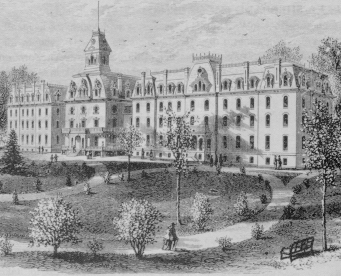In 1866 the so-called "Baptist College" was named the Nashville Normal and Theological Institute and relocated in Union Army barracks on Cedar (Charlotte) between Spruce (Eighth Avenue, North) and McLemore (Ninth Avenue, North) streets. The American Baptist Home Mission Society of New York, local blacks and other contributors funded the freedmen's school.
In 1867 the school moved into a two-story frame building at Park and Polk streets. Merry traveled to Memphis and held church benefits to raise money for the school. In 1869 a group headed by Phillips attempted to purchase surplus Union Army Fort Gillem adjacent to them at Salem (18th Avenue, North) and Jefferson Streets but Fisk University bought the property. When Fisk's Jubilee Hall rose next door, Phillips raised $30,000 and purchased thirty acres of the William H. Gordon farm on Hillsboro Road by 1874.
 On February 13,
1883, the school was incorporated as Roger Williams University. Several
blacks, including Merry and Randall V. Vandavall (1832 -1898), served on
the board of trustees. The school added a master's degree in 1886 and continued
to expand until the 1890s, when student rebellion and white suburbanization
of West Nashville caused its decline.
On February 13,
1883, the school was incorporated as Roger Williams University. Several
blacks, including Merry and Randall V. Vandavall (1832 -1898), served on
the board of trustees. The school added a master's degree in 1886 and continued
to expand until the 1890s, when student rebellion and white suburbanization
of West Nashville caused its decline.
After Vanderbilt University established itself in the vicinity and the Belmont area was under development by realtors, a realtor offered the American Baptist Home Mission Society $150,000 for the Roger Williams campus. The discussion of whether to sell the campus was influenced by the student rebellion of 1888-89, in which the blacks had charged the president with racism and caused him to resign. But the ABHMS refused to sell the school.
On the night of January 24, 1905, at ten o'clock, a mysterious fire destroyed Centennial Hall. The school reopened, but on May 22, 1905, another fire of unknown origin leveled Mansion House. The American Baptist Home Mission Society closed Roger Williams University and subsequently sold part of the land to realtors and the rest to George Peabody College for Teachers by 1911. Realtors subdivided the land for resale, with covenants on the deeds that restricted sale to any "person of African descent."
Local black leaders were upset that the white Baptists had closed "their school" built by Merry, Vandavall, and Phillips. As a result, the Negro Baptist Association of Tennessee formed the Tennessee Missionary and Education Association to raise $10,000 and purchase a new campus on Whites Creek Pike. In the fall of 1909, Roger Williams University was reopened in North Nashville, with its first black president. By 1922, however, there were only 159 students and twelve faculty members. On July 12, 1927, the decision was made to merge the school with Howe Institute in Memphis (LeMoyne-Owen College). The students and teachers left for Memphis on December 29, 1929.